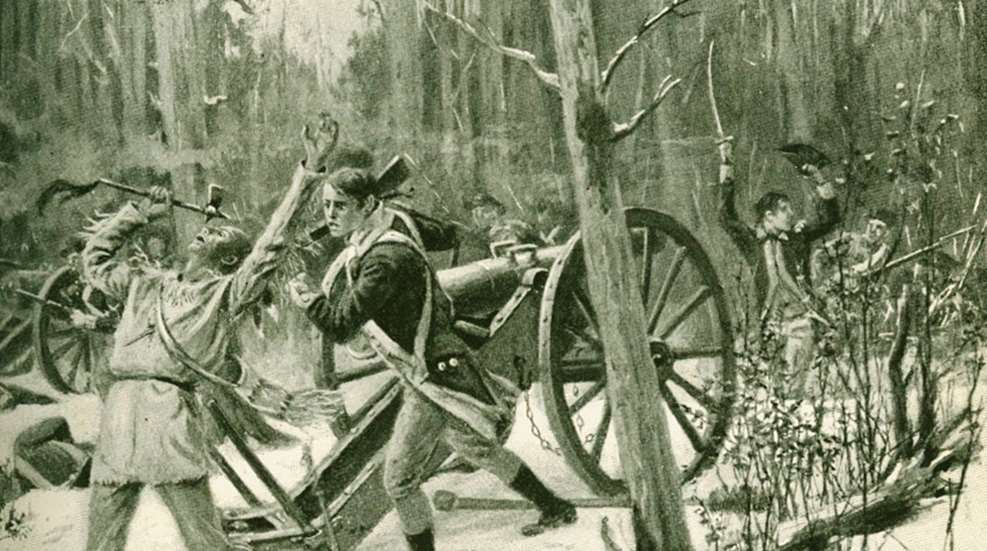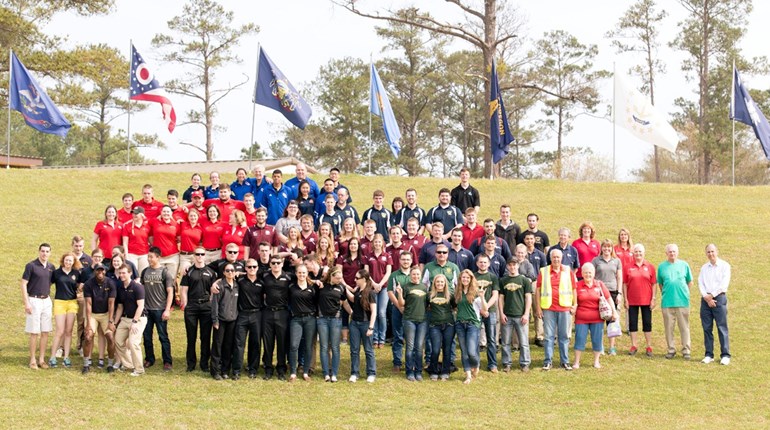
The greatest defeat of an American military force at the hands of Native Americans did not happen along the Little Bighorn River in 1876 in Montana Territory. Rather, it occurred 85 years earlier and 1,000 miles to the east, along the headwaters of the Wabash River in the Northwest Territory. Three times more soldiers were killed in that battle than died at Custer’s Last Stand.
Leading the American army in 1791 was Major General Arthur St. Clair, a veteran of the American Revolution. He had been assigned to Fort Washington along the north shore of the Ohio River—what one day would become the city of Cincinnati, Ohio—and ordered to raise and train an army of 3,000 men, made up of both regulars and militia. His assignment then, from President George Washington through Secretary of War Henry Knox, was to march the army north by late summer and attack any Indians encountered, punishing them for raids the tribes were making south of the Ohio River into Kentucky.
Warriors were stealing horses, burning cabins, taking prisoners, and, at times, killing and scalping entire families. In defense of the Indians—mainly the Miami and Shawnee tribes were involved—they believed they had no choice but to resort to violence. For years, European settlers had been illegally encroaching on Indian lands north of the Ohio, lands granted to the Indians by treaty. But after years of complaining to the American government about the incursions with little result, the tribes had drawn a line in the sand. It was frontier border warfare at its most brutal.
The St. Clair expedition seemed snake-bit from the start. Men were slow to volunteer as soldiers and the promised supplies from upriver in the east were even slower in arriving. The expected marching date of August 1 came and went; it was not until more than six weeks later, September 17, that the army marched north. And it did not march with the anticipated 3,000 soldiers.
The army consisted of just 1,400 men, only half of whom were veterans, the other half raw recruits. So few supplies had arrived that on the very first day of the march St. Clair was forced to place his entire army on half rations. He did so counting on the promised supply train to catch up eventually. Also slowing the march were nearly 500 camp-followers: wives, girlfriends, "girlfriends" and even children, all constantly begging food from the soldiers.
The Indians, on the other hand, had been well supplied by the British and numbered nearly 3,000 warriors. Co-led by Little Turtle, principal chief of the Miamis; and Blue Jacket, war chief of the Shawnees, they were prepared and itching for a fight.
To make matters worse for the army, one night during the campaign 300 militia members deserted, further weakening the force. St. Clair sent 150 regulars to arrest them and bring them back. So now the army numbered just over 900 men.
The weather had been unusually cold with some snow already that fall. The army’s march finally ground to a halt on November 3, the soldiers and camp-followers exhausted, cold and hungry. St. Clair said they would camp where they were and await the supply pack train.
It was at that moment during the campaign that Major General Arthur St. Clair made the worst decision of his long military career. Because of the army’s fatigue and the fact that it was already late in the day, he allowed that no fortifications need be built around the perimeter of the camp, as usual. The soldiers could take care of that chore first thing in the morning.
Indian spies—led by a young Shawnee warrior named Tecumseh—had been watching the plodding, lumbering army ever since it left Fort Washington and now couldn’t believe their good fortune. Racing back to Little Turtle and Blue Jacket, they explained what was happening. Some of the chiefs argued to attack immediately, as soon as darkness fell, but a cooler, more experienced head overruled them.
“No!” said Blue Jacket. “If we attack in the dark there are so many of us we will surely kill one another. Brothers, we must wait until dawn. And then…” he paused, “and then we will kill all the Long Knives!”
The Indians spent the night slowly creeping through the woods into position, a half-foot of fresh snow muffling their footsteps. It was at the first light of dawn they sprung their surprise attack. With a tremendous, simultaneous roar of hideous war cries, warriors swarmed from the woods by the hundreds. The army’s advance guard got off only a few scattered shots before throwing down their guns and running for their lives back toward camp. Their panic was contagious, and soon the entire army was in chaos, milling about in total confusion.
St. Clair had suffered for years with gout that caused tremendous pain in his feet when walking. Consequently, he needed a horse to ride while commanding the army and one was quickly brought to him. But the battle soon became so fierce that the horse was shot dead from under him, as were two more in quick succession. At one point, the general was reduced to crawling about on his hands and knees in the snow that had become red-tinged slush, shouting orders.
The battle lasted some three hours before St. Clair ordered his army, or what was left of it, to retreat. The remaining soldiers grouped together, charged toward the Indian line to the south, broke through and kept moving as fast as they could. But it was more of a rout than a controlled retreat, with men trampling one another to get to the head of the column. The Indians, mercifully, chose not to pursue.
By noon it was all over. Sixty-six Indians had been killed, but the bodies of 832 American soldiers and camp-followers were scattered grotesquely over the battlefield. Of the 52 officers in the fight, 39 had been killed and seven wounded. General St. Clair himself had eight bullet holes in his clothing and hat but was otherwise not hit. Only 24 men returned to Fort Washington uninjured, the remnants of the army straggling in about the same time the much-anticipated supplies arrived from upriver.
Upon hearing the news of the battle a month later in early December, President George Washington was livid. “Beware of surprise I told him!” speaking of his last instructions to General St. Clair before sending him off on campaign.
“You know how the Indians fight us! And yet!—to suffer the army to be cut to pieces, hacked, butchered, tomahawked, by a surprise—the very thing I guarded him against! Oh, God! Oh, God, he is worse than a murderer! The curse of the slain is upon him, the curse of widows and orphans, the curse of Heaven!”
President Washington would choose a much wiser military commander to send against the Indians next time. His name was General “Mad Anthony” Wayne, and in the 1794 Battle of Fallen Timbers the American army would prevail. It would be the final battle of the Northwest Indian War.






































